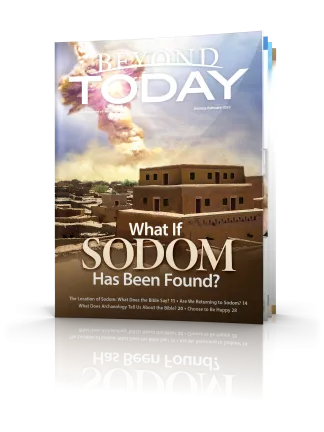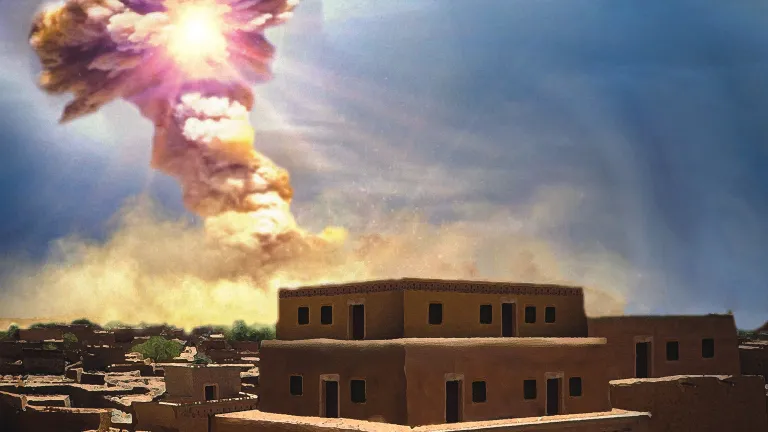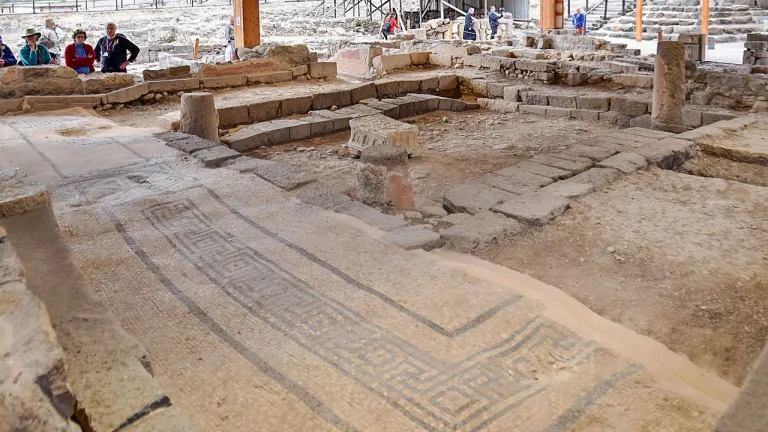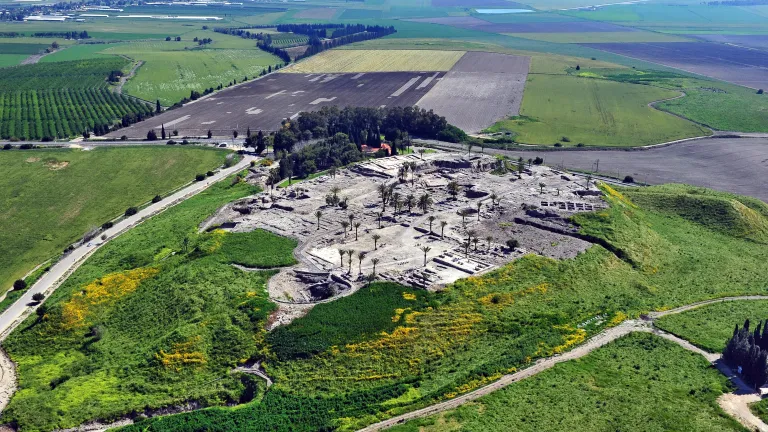The Location of Sodom: What Does the Bible Say?
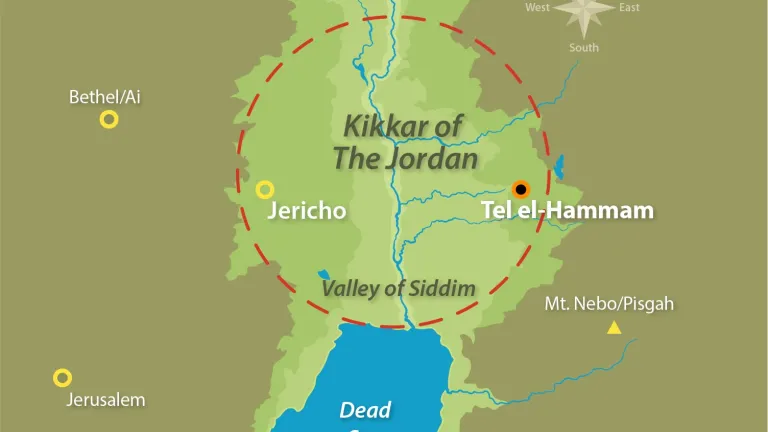
Is the biblical story of Sodom real or only a fanciful myth? When we examine the biblical evidence, it reveals a consistent story about a specific location—one that may prove to be ancient Sodom itself.
Was Sodom a real city? The biblical story of its fiery destruction due to its wickedness sounds like a fantasy to many, so it’s often been dismissed as a fable. But do we have real evidence for the existence of Sodom and its destruction? Evidence for a large-scale cataclysmic destruction event in the lower Jordan Velley that destroyed many towns is covered in the lead article in this issue, “What If Sodom Has Been Found?”
But was Sodom one of those cities destroyed in that event? If Sodom was real, where was it located? Does evidence point us to a specific location?
Sodom’s first mention in the Bible
Sodom appears quite early in the biblical account, first on the borderland of Canaan in Genesis 10:19 and then in Genesis 13 with the story of the patriarch Abraham. He was a wealthy man, “very rich in livestock, in silver, and in gold” (verse 2). He was traveling with his nephew Lot, who “had flocks and herds and tents” of his own (verse 5). Today we would call them Bedouins—large tent-dwelling extended families and servants with their families who traveled from place to place where they could find sufficient pasturage for their herds of sheep, goats and camels.
We break into the story flow when Abraham, then named Abram, and Lot were “between Bethel and Ai” (verse 3), towns located in the mountains a few miles north of modern-day Jerusalem. There the two men had a problem: “Now the land was not able to support them, that they might dwell together, for their possessions were so great that they could not dwell together. And there was strife between the herdsmen of Abram’s livestock and the herdsmen of Lot’s livestock” (verses 6-7).
There simply wasn’t enough grass to feed all of the animals they owned. Abraham generously offered a solution to Lot: “Please let there be no strife between you and me, and between my herdsmen and your herdsmen; for we are brethren [or family]. Is not the whole land before you? Please separate from me. If you take the left, then I will go to the right; or, if you go to the right, then I will go to the left.”
“And Lot lifted his eyes and saw all the plain of Jordan, that it was well watered everywhere (before the Lord destroyed Sodom and Gomorrah) like the garden of the Lord, like the land of Egypt as you go toward Zoar. Then Lot chose for himself all the plain of Jordan, and Lot journeyed east. And they separated from each other. Abram dwelt in the land of Canaan, and Lot dwelt in the cities of the plain and pitched his tent even as far as Sodom” (verses 10-12). And then the Bible adds this ominous footnote: “But the men of Sodom were exceedingly wicked and sinful against the Lord.”
Pointing the way to Sodom
Let’s examine what we’re told here about the location of Sodom based on the markers given in the biblical text. We are grateful to Dr. Steven Collins, dean of the College of Archaeology and Biblical History at Trinity Southwest University in Albuquerque, New Mexico, for highlighting these markers and his extensive research on the subject (readers can learn more at tallelhammam.com).
As seen on the accompanying map, Bethel and Ai are close together north of Jerusalem. They are on the hilly mountainous ridge that runs north-south roughly down the middle of the land of Israel. From here “Lot lifted his eyes and saw all the plain of Jordan” (the Jordan River Valley), and “that it was well watered everywhere,” like the Garden of Eden and Egypt, lush because of the Nile River (verse 10).
From these mountains overlooking the Jordan River Valley, Lot chose that lush area and “journeyed east . . . and Lot dwelt in the cities of the plain and pitched his tent even as far as Sodom” (verse 12). This tells us Lot’s direction of travel—east—and where he settled, at Sodom. So Sodom was somewhere east of Bethel and Ai in the Jordan River Valley north of the Dead Sea.
We can further identify the location of Sodom when we examine the Hebrew word kikkar, translated “plain” here in verses 10, 11 and 12. The Complete Word Study Dictionary: Old Testament explains that this word means “something round, such as a coin (a talent); a district; a loaf of bread [that is, a round flatbread or pita]. It indicates something round, dish-shaped, circular . . .” It does mean something flat, as with our English word “plain,” but more specifically something flat and round or circular —disk-shaped, like the objects mentioned.
Referring to the map again, note the large circular plain just north of the Dead Sea, which fits this description perfectly. I’ve stood in this plain and it’s remarkable how the mountains to the north and south curve around and inward at the north and south to form this large disklike area. Bisecting this round plain is the Jordan River, and flowing from the mountains to the east and west are a number of streams and wadis that, centuries ago, would have truly made this area “well-watered everywhere,” just as described in the Bible.
Interestingly, eight different Hebrew words are translated “plain” in the Bible in referring to a level area, valley, meadow or low place. The word kikkar is translated “plain” only in connection with this one area—the circular “plain” of the Jordan River Valley. Thus kikkar seems to describe only this specific geographic/geologic feature in the Jordan River Valley—better translated the “disk of the Jordan.”
And on the eastern edge of this disk, directly east of Bethel and Ai, lies a huge buried city at a location today called in Arabic Tall el-Hammam. Dr. Collins and his archaeological team have excavated the site for 15 seasons and have found powerful evidence pointing to it as the likely site of ancient Sodom.
Problems with a southern Dead Sea location
These geographic and directional markers from the Bible present a major problem for the view that Sodom and the other cities of the plain were located near or under what is today the southern end of the Dead Sea, as indicated in many Bible maps and charts.
That view was popularized with excavations at some settlements in that area long ago. However, research has shown that those settlements were abandoned far earlier than any reasonable date for the biblical story of Sodom. No physical evidence exists for placing Sodom and the cities of the plain in that area.
The Bible’s description of Sodom being in the “well watered” plain of the Jordan also does not fit a location near the southern end of the Dead Sea, since the Jordan River enters the northern end of the Dead Sea but no river enters or exits at the south. Nor are there major springs and streams in that area.
Another problem with this view is that the southern end of the Dead Sea is nowhere near Bethel and Ai, the area where Abraham and Lot looked out over the plain and separated, with Lot traveling east to Sodom. The southern end of the Dead Sea isn’t even visible from where Abraham and Lot were when they made this agreement, as it was blocked from view by mountains. Only the northern part of the Dead Sea is visible from the area where Abraham and Lot were.
Some argue that Lot merely initially went to the east side of the Jordan Valley and much later ranged far toward a southern Sodom. But that is not the sense of Genesis 13:12, with Sodom being among the cities of the kikkar (compare Genesis 19:25, 29).
Sodom and the cities of the plain
The Bible gives us other clues about the location of Sodom and its surroundings. Genesis 14:1-17 records a brief war between city-states. From Mesopotamia came kings of Babylon and nearby countries with their forces. Another local alliance of the rulers of Sodom, Gomorrah, Admah, Zeboiim and Bela/Zoar, who had been subject to the Mesopotamians, rebelled when the first group was returning from a military campaign in the south.
They battled in the “Valley of Siddim,” referring to the area surrounding the Dead Sea (verses 3, 10). The ruler of Sodom was defeated along with his allies, and the victors headed north with their plunder—which included Abraham’s nephew Lot among the captives taken. Abraham pursued them with his own small private army, overtook them and rescued his nephew.
From this account we learn more about Sodom. It was part of an alliance with four other cities that were “joined together” in this area, showing they were near each other (verse 3). Also, when the Bible repeatedly links two cities or towns together, as we see with “Sodom and Gomorrah” in this chapter and more than a dozen other places in the Bible, this indicates that the two are geographically very close to one another—typically only a mile or two (or less) apart.
From the site of Tall el-Hammam, which a growing number of scholars are accepting as the location of ancient Sodom, one can see several mounds in which the remains of other ancient cities are buried, including one about a mile north that may be Gomorrah. Others nearby may well be some of the other “cities of the plain.” Archaeological evidence shows that all these cities, along with dozens of smaller towns and settlements in the area, were abandoned at the same time and not resettled for the next 300 to 600 years.
While not conclusive, this evidence is certainly consistent with the likelihood that Tall el-Hammam could indeed be the location of ancient Sodom.
Further evidence from the Bible
The Bible gives other hints that are consistent with this being the likely location of Sodom.
Genesis 19 describes the sudden destruction of Sodom: “Then the Lord rained brimstone and fire on Sodom and Gomorrah, from the Lord out of the heavens. So He overthrew those cities, all the plain, all the inhabitants of the cities, and what grew on the ground” (verses 24-25).
Again, the archaeological evidence shows that the entire area around Tall el-Hammam was abandoned for the next three to six centuries. Much of the soil was saturated with such a high salt content that agriculture—and thus human habitation—was impossible for centuries after.
The possible explanation for this elevated salt content, as described in the accompanying article “What If Sodom Has Been Found?”, is that a comet or meteor explosion near the northern end of the Dead Sea vaporized thousands of tons of salt-laden Dead Sea water, which later rained down from the sky and poisoned the land for miles around.
The Bible also tells us that after this fiery destruction came from the sky, Abraham, now living near Hebron, “looked toward Sodom and Gomorrah, and toward all the land of the plain; and he saw, and behold, the smoke of the land which went up like the smoke of a furnace” (Genesis 19:28). Abraham’s location was in the mountains west of the Dead Sea. He could’ve easily seen the smoke of such vast destruction from there, and with a short hike to a nearby hilltop he could’ve looked at the northern end of the Dead Sea and directly seen the devastated landscape.
We discover yet another clue centuries later when the Israelites were preparing to enter the Promised Land from what is today the Hashemite Kingdom of Jordan. Numbers 21 recounts part of their journey, including a stop at Pisgah, which is very near Mt. Nebo—a popular tourist stop today and the spot where Moses looked across the Jordan Valley to the Promised Land before his death. The key phrase to note here is in verse 20, where Mt. Pisgah “looks down on the wasteland”—speaking of the Jordan River Valley spread out below it.
Of itself this doesn’t seem to mean much. But keep in mind that, centuries earlier, Abraham and Lot had looked across that same valley from the opposite (western) side and it was described as “well watered everywhere” (Genesis 13:10) and like the Garden of Eden. But now it is described as “the wasteland.” The lush, well-watered valley that looked so attractive to Lot was now, centuries later, a desolate, abandoned wasteland!
What had happened between those two events? The Bible tells us. God rained fiery destruction on Sodom and Gomorrah and the nearby cities and villages, burning them to ash and cinders. It became a wasteland, and it was still a wasteland centuries later.
So what does the Bible tell us about the location of Sodom? Actually, it reveals a great deal. The evidence points strongly toward Tall el-Hammam being a likely candidate for the site of ancient Sodom. It’s in the right place, at the right time, with the right scientific evidence pointing toward a sudden fiery destruction! The study and research will continue, and no doubt further discoveries will come to light.
In the meantime, what is important is that we heed the apostle Peter’s warning in 2 Peter 2:6 (Christian Standard Bible): God “reduced the cities of Sodom and Gomorrah to ashes and condemned them to extinction, making them an example of what is coming to the ungodly.” We pray that you and all have ears to hear!
